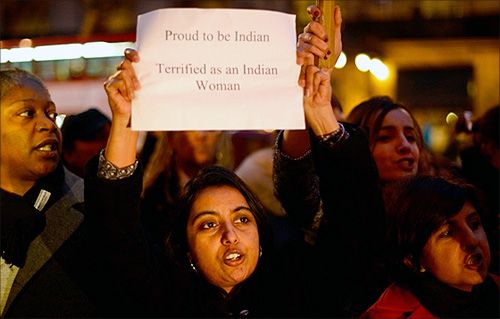Physical security for women, the first step towards getting them into factories and offices, is all but absent in most Indian cities, notes Kanika Datta.

In recent years, many persuasive arguments have been forwarded for increasing women's participation in the workplace, from maximising talent utilisation within organisations to enabling the global economy to grow faster if women achieve their full economic potential.
The latter was the subject of a thought-provoking recent study from McKinsey Global Institute.
Other studies periodically appear that demonstrate - somewhat mystifyingly, it must be said - how companies with a strong representation of women on their boards perform better than those that lack them.
Making a business and economic case for women's participation is certainly a practical way of furthering the cause of gender equality.
There is much to be said for the liberating power of an income earned by a working woman against the chains of dependency for a woman outside the workforce.
Yet, between women's participation in the workforce and gender parity in society there is a gulf called community attitudes that needs to be bridged too, which is why one outcome need not necessarily guarantee the other.
The McKinsey Global study, for instance, unequivocally suggests that gender equality in society cannot be achieved without gender equality in work.
The study maps ten regions of the world, accounting for 93 per cent of the world's female population on the basis of a Gender Parity Score.
It is no surprise that South Asia is the worst performer, scoring even worse than West Asia and North Africa (WANA) and sub-Saharan Africa.
The interesting point to note, however, is that "equality in work" is one of four categories of outcome-based indicators in which gender parity is judged.
The other three are: essential services and enablers of economic opportunity; legal protection and political voice; and physical security and autonomy.
Looked at differently, it is no surprise that countries with high gender parity - western Europe and North America and Oceania - also score high on the three other parameters.
The question, though, is which came first for these countries, the enabling environment or the higher workforce participation for women?
Obviously, the answers differ from country to country, but India is a good example of how and why the two need not converge and why progressive attitudes are needed to foster both.
One case in point is IT and ITeS (Information Technology and Information Technology enabled services), the boom industries of the new century, where women's workforce participation is noticeably high.
Over the past 15 years, however, the enabling environment for women in the cities in which IT dominates has scarcely improved.
For instance, in most European and American cities - not to forget those in east and Southeast Asia - where women's participation in the workforce is high, it is possible for women to travel alone relatively late at night.
In India, no ITeS company can afford to let its women workers take public transport in the late evening hours.
Physical security for women, the first step towards getting them into factories and offices, is all but absent in most Indian cities.
In cities where it could once be taken for granted, like Mumbai or Kolkata, the situation has deteriorated significantly.
Concomitantly, providing secure transport for women employees working in jobs that demand odd hours raises the cost of hiring them.
Increasingly in urban India, the emergence of women with independent incomes and lifestyles has led to an upsurge of aggressive conservatism in the public discourse.
In some cities, working women have been attacked for visiting pubs and bars.
Politicians and self-styled arbiters of public conduct think nothing of openly (and often violently) expressing their opinions on how they think women should dress and behave, creating a perpetually hostile environment for working women.
Finally, consider the corporate scene and it is evident that attitudes have scarcely changed.
It is striking that none of the big Indian-origin IT and ITeS companies - manifestly India's global champions with large numbers of women in their workforces - is headed by a woman.
Contrast this with most of the big name multinational competitors - Accenture, IBM, Capgemini, HP, Facebook, Intel - all of which have had women chief executives.
In India's showcase industry, the relatively high participation of women in the workforce (together with its standard-setting policies for maternity leave and childcare) has not created greater gender parity.
Who or what is responsible for that?










 © 2025
© 2025